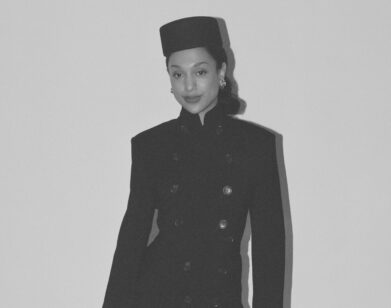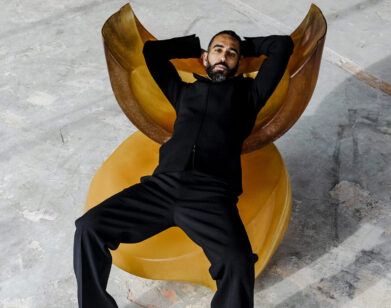Pedro Reyes’s House of Horrors
For his 2007 work Palas por Pistolas, Pedro Reyes, the Mexico City-based artist and cultural agitator, melted 1527 voluntarily donated guns from the crime-ridden city of Culiacan and turned them into 1527 shovels, which were used to plant 1527 trees. In 2012, he revisited the project with Imagine, where weapons were turned into musical instruments, and again in 2013 with Disarm, where more weapons were turned into musical machines. The gun series is an example of Reyes’s obsession with art as a means of social change: literal, tangible change; agents of death-turned-agents of life. The multidisciplinary artist’s previous projects have included forums on the Iraq war, group therapy sessions, and environmentally conscious grasshopper burgers.
His latest work is perhaps his largest in scale, and his biggest departure both stylistically and thematically. In partnership with Creative Time and a team of theatrical collaborators, Reyes has created Doomocracy, a political haunted house. Staged in the cavernous Brooklyn Army Terminal in New York, the installation—a two-hour guided experience, in which viewers are led through a series of spaces—holds a funhouse mirror up to the modern American condition. The presidential election, gun rights, education, abortion, corporate greed, healthcare, contemporary art, and technology are lambasted in equal measure, the results of which are darkly funny and thought provoking. It is an ambitious work, multi-layered and dense, but it is the uncharacteristic absence of hope that makes the experience truly haunting. Reyes offers no solutions for the horrors of American life, just the catharsis of experiencing them anew.
MATT MULLEN: What was the initial spark of inspiration for the piece? And from that, how did the work turn into what it is now?
PEDRO REYES: It started with the idea of the haunted house. I’m interested in the folkloric, and Halloween is true American folklore—the time of the year when people allow themselves to go crazy. Especially in New York, where everyone becomes an artist. Doing a haunted house was a Trojan Horse, because it opened an opportunity to talk about issues in politics that if you treat them just seriously are quite depressing and too heavy. You must have a shock factor. A haunted house is a sort of masochistic experience. For example, when you start the experience there’s this brutal stop and frisk experience.
MULLEN: It brings up the idea of art as catharsis.
REYES: Yes. It was so interesting how for the team, the worse the news got, the better it was for the project. We combined many things. If you think of the abortion room, you have the interpretation of high school musicals, like Grease, and then you have the haunted house reference, which is where radical religious groups make shows to scare you about hell. But also, Halloween came out of the same issues of burning women for having sexual freedom, so the parallel reality that we created in this space is that you have these cheerleaders who are a very strange reference to what the origins of Halloween actually means. We mixed things from different cultural backgrounds, but also with a political agenda. It’s like political theater, but with all the fantasies Halloween allows you.
MULLEN: You seemed to rely on a lot of stereotypes in the piece, like the cheerleaders or the gun rights moms. How did you manage to reanimate them?
REYES: I think it’s interesting to explore genera. Every room has a different theme, but also a different treatment—some are B-movie sci-fi, like the elevator of climate change. I myself have never ventured much into camp, but the beauty of this project is that haunted houses, in and of themselves, are considered cheap. The campiness is fine in this context. There are rooms that are more melodrama, for instance the doctor’s office. Others are more surreal, like the coffin salesman. And there are rooms that are more sobering, like the drone room. Others are more interactive, like the football game or the boardroom; in the boardroom, depending on how you vote, you have this situation where you either end up enjoying a cocktail party, or being the help.
MULLEN: Yes, I voted smartly to take the golden parachute, so I had a lovely time at the cocktail party and drank some champagne.
REYES: Did you hear the story of the rocket?
MULLEN: Of course. You’re mentioning all these aesthetic inspirations. What else inspired you?
REYES: I have always cared for the subject of guns, and I have always been very interested in the issue of drugs, because as much as illegal drugs are prosecuted, if you think of it as a health issue, the real killer are prescription drugs, like over prescribing of opioids. Also, there’s the price of technology. As a parent, my main activity is to block screen access with my kids, because otherwise they would spend all day on the computer. So the “classroom of the future” was for me an opportunity to mock this idea of computers in education, which I think has been very bad. In general, I think schools should be computer-free zones. I mock technology in other moments, like the VR forest. It was a fad 30 years ago and I think it’s a fad again. And the idea of the rocket—that’s me mocking the enthusiasm of people like Elon Musk, saying that he is going to build a rocket for Mars. People feel that that is an exciting project, but if you see the refugees around the world and the millions of homeless people, then for me it’s insulting that people are fantasizing about leaving planet Earth and going wherever. These are social situations that I feel strongly about. I wanted to show the dystopia of modern life.
MULLEN: The political agenda seems so New York City centric. Can you imagine this piece being staged elsewhere? Like, say, Kansas City?
REYES: I think the same show could restaged, but it would be very different. It would be great to see it in a, well, red state. I would be very curious to see what the reaction of something like that would be.
MULLEN: I was sort of surprised there was no glimmer of hope at the end of the show, or solutions for how to fix anything. You’re just led, rather unceremoniously, out the back door. Was that a conscious choice?
REYES: Yes. Often much of my work is very optimistic, or solution-based. I have always believed that art is a tool for transformation, and something that should give people some kind of agency. But this is a haunted house, so if you let even one ray of hope enter the project it betrays the essence of the whole thing. We needed to be consistent. It’s a dark piece.
CREATIVE TIME AND BROOKLYN ARMY TERMINAL’S PRESENTATION OF PEDRO REYES’ DOOMOCRACY WILL TAKE PLACE THROUGH NOVEMBER 6, 2016 ON FRIDAYS, SATURDAYS, AND SUNDAYS. FOR MORE ON PEDRO REYES, VISIT HIS WEBSITE.







